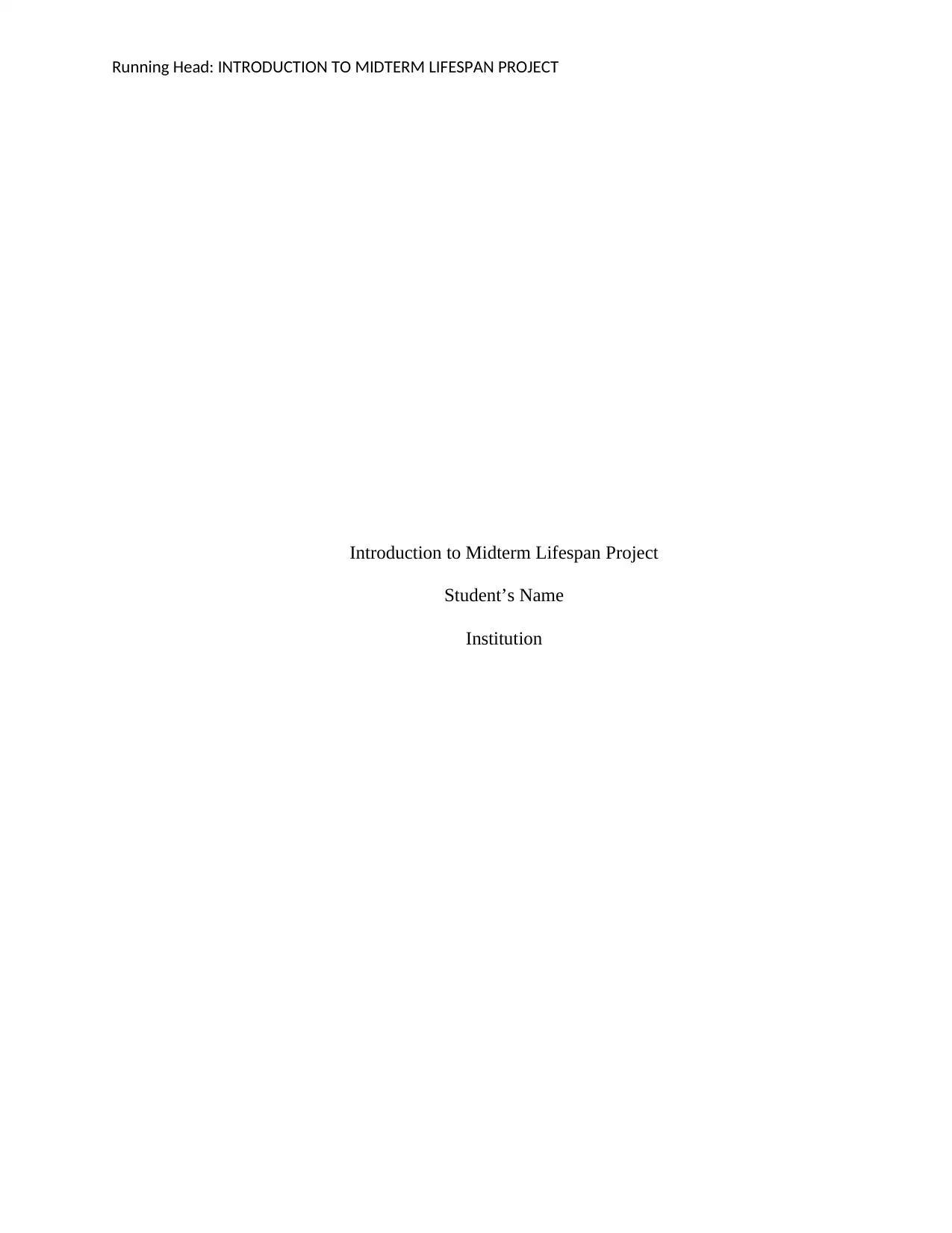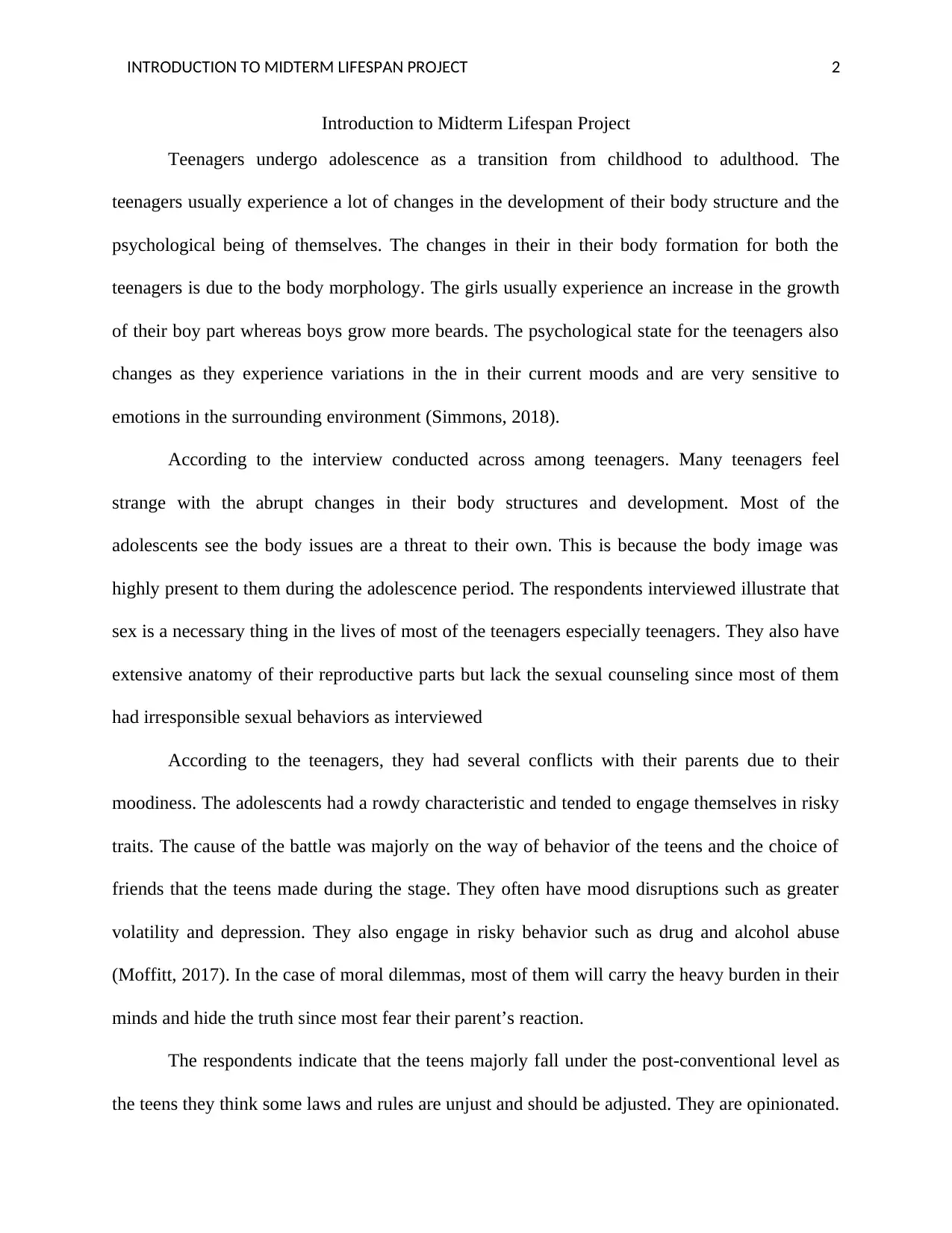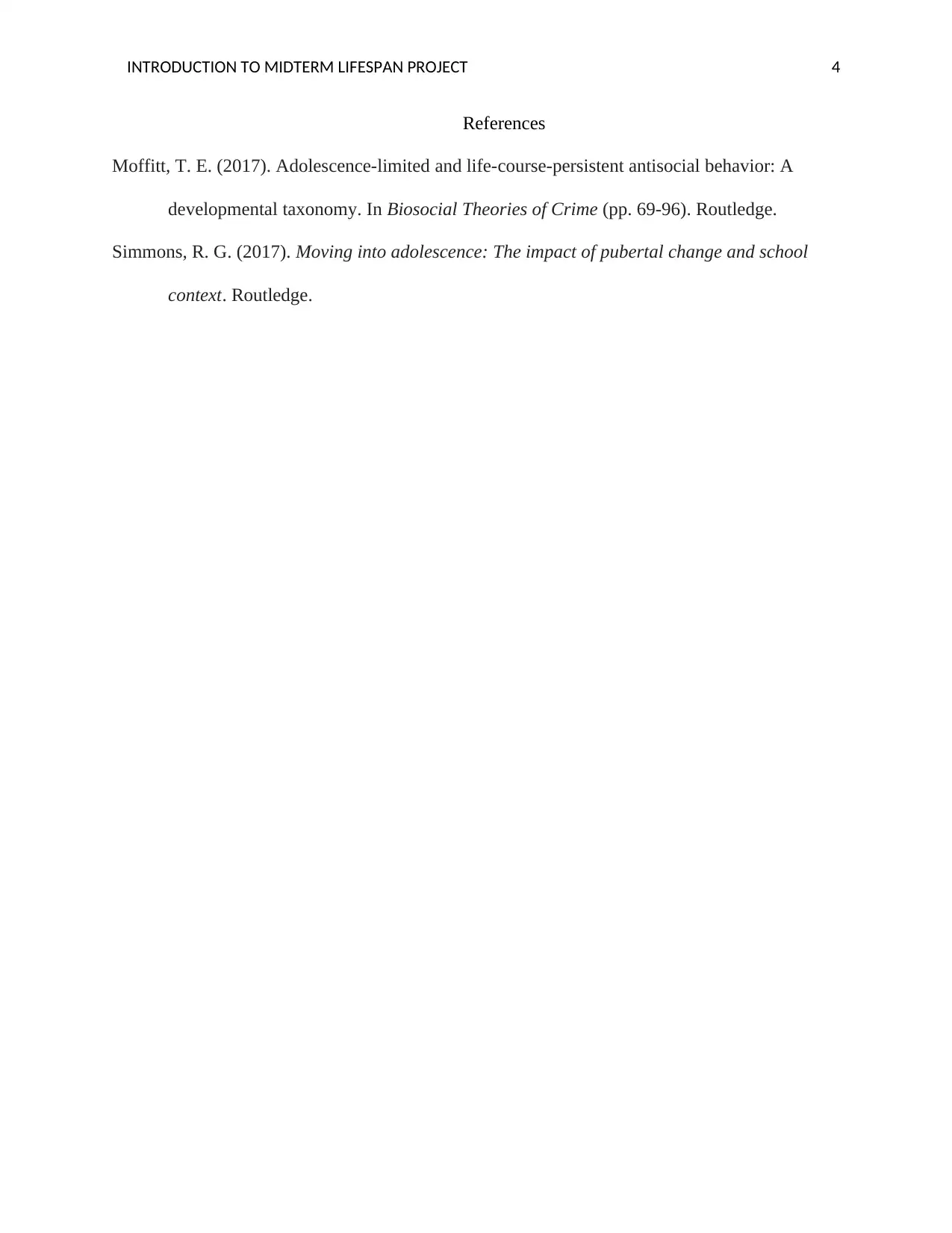Adolescence and Teenagers: Changes, Challenges, and Coping Mechanisms
VerifiedAdded on 2023/06/03
|4
|597
|64
AI Summary
This article discusses the changes, challenges, and coping mechanisms of teenagers during adolescence. It covers the physical and psychological changes, conflicts with parents, moral dilemmas, and preferences of teenagers. The biggest challenge facing teenagers is also highlighted.
Contribute Materials
Your contribution can guide someone’s learning journey. Share your
documents today.

Running Head: INTRODUCTION TO MIDTERM LIFESPAN PROJECT
Introduction to Midterm Lifespan Project
Student’s Name
Institution
Introduction to Midterm Lifespan Project
Student’s Name
Institution
Secure Best Marks with AI Grader
Need help grading? Try our AI Grader for instant feedback on your assignments.

INTRODUCTION TO MIDTERM LIFESPAN PROJECT 2
Introduction to Midterm Lifespan Project
Teenagers undergo adolescence as a transition from childhood to adulthood. The
teenagers usually experience a lot of changes in the development of their body structure and the
psychological being of themselves. The changes in their in their body formation for both the
teenagers is due to the body morphology. The girls usually experience an increase in the growth
of their boy part whereas boys grow more beards. The psychological state for the teenagers also
changes as they experience variations in the in their current moods and are very sensitive to
emotions in the surrounding environment (Simmons, 2018).
According to the interview conducted across among teenagers. Many teenagers feel
strange with the abrupt changes in their body structures and development. Most of the
adolescents see the body issues are a threat to their own. This is because the body image was
highly present to them during the adolescence period. The respondents interviewed illustrate that
sex is a necessary thing in the lives of most of the teenagers especially teenagers. They also have
extensive anatomy of their reproductive parts but lack the sexual counseling since most of them
had irresponsible sexual behaviors as interviewed
According to the teenagers, they had several conflicts with their parents due to their
moodiness. The adolescents had a rowdy characteristic and tended to engage themselves in risky
traits. The cause of the battle was majorly on the way of behavior of the teens and the choice of
friends that the teens made during the stage. They often have mood disruptions such as greater
volatility and depression. They also engage in risky behavior such as drug and alcohol abuse
(Moffitt, 2017). In the case of moral dilemmas, most of them will carry the heavy burden in their
minds and hide the truth since most fear their parent’s reaction.
The respondents indicate that the teens majorly fall under the post-conventional level as
the teens they think some laws and rules are unjust and should be adjusted. They are opinionated.
Introduction to Midterm Lifespan Project
Teenagers undergo adolescence as a transition from childhood to adulthood. The
teenagers usually experience a lot of changes in the development of their body structure and the
psychological being of themselves. The changes in their in their body formation for both the
teenagers is due to the body morphology. The girls usually experience an increase in the growth
of their boy part whereas boys grow more beards. The psychological state for the teenagers also
changes as they experience variations in the in their current moods and are very sensitive to
emotions in the surrounding environment (Simmons, 2018).
According to the interview conducted across among teenagers. Many teenagers feel
strange with the abrupt changes in their body structures and development. Most of the
adolescents see the body issues are a threat to their own. This is because the body image was
highly present to them during the adolescence period. The respondents interviewed illustrate that
sex is a necessary thing in the lives of most of the teenagers especially teenagers. They also have
extensive anatomy of their reproductive parts but lack the sexual counseling since most of them
had irresponsible sexual behaviors as interviewed
According to the teenagers, they had several conflicts with their parents due to their
moodiness. The adolescents had a rowdy characteristic and tended to engage themselves in risky
traits. The cause of the battle was majorly on the way of behavior of the teens and the choice of
friends that the teens made during the stage. They often have mood disruptions such as greater
volatility and depression. They also engage in risky behavior such as drug and alcohol abuse
(Moffitt, 2017). In the case of moral dilemmas, most of them will carry the heavy burden in their
minds and hide the truth since most fear their parent’s reaction.
The respondents indicate that the teens majorly fall under the post-conventional level as
the teens they think some laws and rules are unjust and should be adjusted. They are opinionated.

INTRODUCTION TO MIDTERM LIFESPAN PROJECT 3
The teenagers argue that non-suicidal injury is detrimental towards dealing with pain that they
endure, but other teenagers suggest that it should not be considered whatsoever. The teenagers
tend to prefer cliques than crowds. The teens prefer cliques because they respond by saying that
the crowds are very immature and a bit messy. The important relationships existing to the teens
as per the interview is the boy child and girl child friends. However, according to the teens,
parent-child is critical too.
Most of the teens prefer partying when handling stress. To the respondents, listening to
music is the hobby. They have a diverse taste in the genres of music. The biggest challenge
facing teenagers is themselves. They are so engaged about others opinions and forget themselves
and their priorities.
The teenagers argue that non-suicidal injury is detrimental towards dealing with pain that they
endure, but other teenagers suggest that it should not be considered whatsoever. The teenagers
tend to prefer cliques than crowds. The teens prefer cliques because they respond by saying that
the crowds are very immature and a bit messy. The important relationships existing to the teens
as per the interview is the boy child and girl child friends. However, according to the teens,
parent-child is critical too.
Most of the teens prefer partying when handling stress. To the respondents, listening to
music is the hobby. They have a diverse taste in the genres of music. The biggest challenge
facing teenagers is themselves. They are so engaged about others opinions and forget themselves
and their priorities.

INTRODUCTION TO MIDTERM LIFESPAN PROJECT 4
References
Moffitt, T. E. (2017). Adolescence-limited and life-course-persistent antisocial behavior: A
developmental taxonomy. In Biosocial Theories of Crime (pp. 69-96). Routledge.
Simmons, R. G. (2017). Moving into adolescence: The impact of pubertal change and school
context. Routledge.
References
Moffitt, T. E. (2017). Adolescence-limited and life-course-persistent antisocial behavior: A
developmental taxonomy. In Biosocial Theories of Crime (pp. 69-96). Routledge.
Simmons, R. G. (2017). Moving into adolescence: The impact of pubertal change and school
context. Routledge.
1 out of 4
Your All-in-One AI-Powered Toolkit for Academic Success.
+13062052269
info@desklib.com
Available 24*7 on WhatsApp / Email
![[object Object]](/_next/static/media/star-bottom.7253800d.svg)
Unlock your academic potential
© 2024 | Zucol Services PVT LTD | All rights reserved.